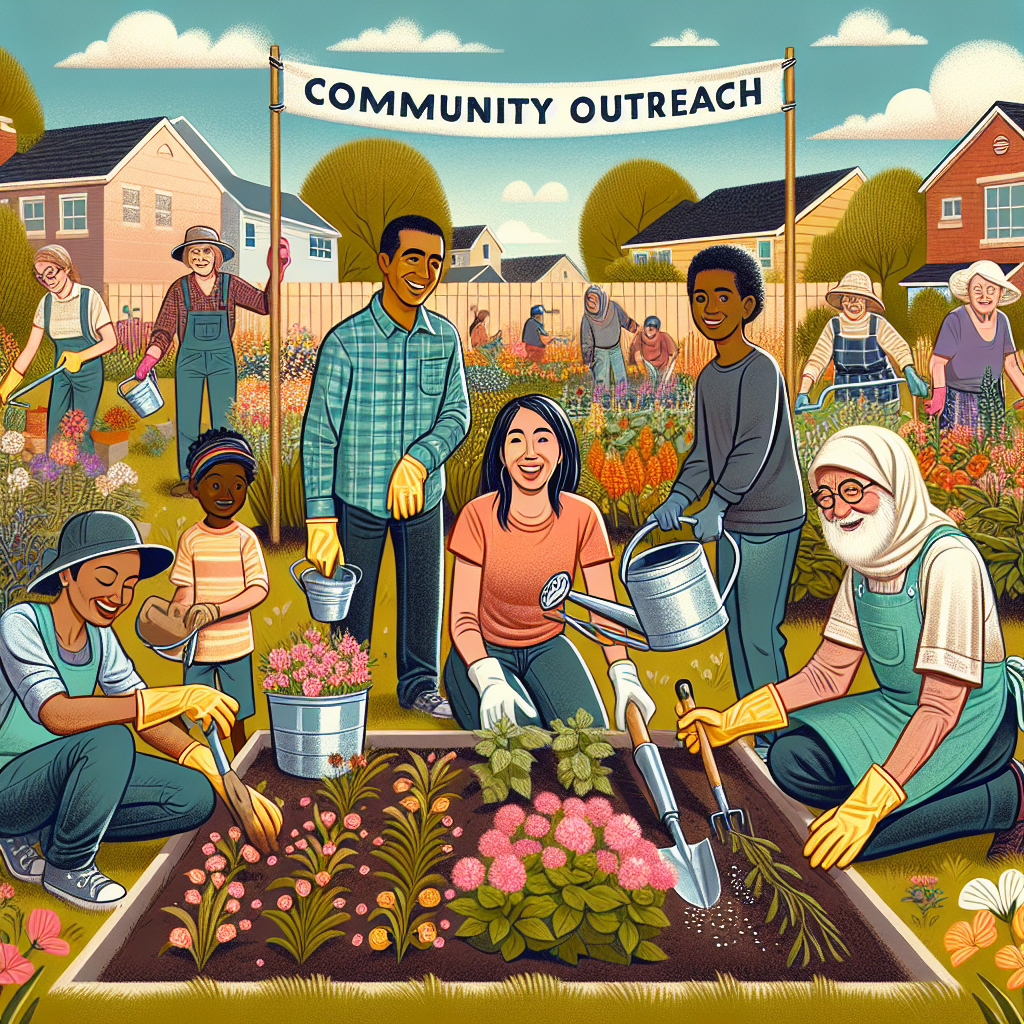Community outreach programs play a crucial role in bridging the gap between people in need and essential resources. These programs aim to provide support and assistance to individuals and families who are facing various challenges such as poverty, homelessness, and lack of access to healthcare. Through creating a sense of unity and solidarity within a community, outreach programs promote social cohesion and help build a stronger, more resilient society. By offering valuable services and resources, such as food banks, counseling, and educational workshops, these programs empower individuals to overcome obstacles and improve their overall well-being. Community outreach programs are a vital lifeline for those in need, fostering a culture of compassion and support within our neighborhoods.
Understanding the Role of Community Outreach Programs
Defining Community Outreach Programs
Understanding the Role of Community Outreach Programs
-
Definition of Community Outreach Programs:
Community outreach programs are initiatives designed and implemented by organizations to engage with and support communities in various ways. These programs aim to bridge gaps, provide resources, and create opportunities for community members to improve their quality of life. -
Objectives and Goals of Community Outreach Programs:
- Building Relationships: One of the primary objectives of community outreach programs is to establish strong connections with community members, fostering trust and collaboration.
- Education and Awareness: These programs often focus on educating the community about important issues, such as health, safety, and social services, to empower individuals with knowledge.
- Providing Support: Community outreach programs offer support services, such as access to healthcare, food assistance, and educational resources, to address the specific needs of the community.
- Empowerment and Advocacy: By empowering individuals to voice their concerns and advocate for change, these programs help communities become more resilient and self-sufficient.
Historical Context of Community Outreach Programs
- Evolution of community outreach initiatives
Community outreach programs have a long history dating back to ancient times when communities would come together to support one another during times of need. The evolution of these initiatives can be traced through various historical periods, such as the Industrial Revolution, where communities organized to address the social and economic challenges brought about by rapid urbanization. Over time, these programs have adapted to meet the changing needs of communities, from providing basic necessities like food and shelter to offering educational and healthcare services.
- Impact of historical events on community outreach efforts
Historical events have played a significant role in shaping community outreach efforts. For example, during times of war or natural disasters, communities have often mobilized to provide aid and support to those affected. The Civil Rights Movement in the United States also saw the rise of community outreach programs aimed at addressing systemic racism and inequality. These events not only highlighted the importance of community solidarity but also underscored the need for structured outreach programs to address social issues effectively.
Benefits of Community Outreach Programs
Social Impact
Community outreach programs play a vital role in strengthening community bonds by fostering a sense of unity and collaboration among residents. These programs provide platforms for individuals from diverse backgrounds to come together, interact, and work towards common goals. By engaging in various community activities and projects, participants develop a shared sense of purpose and belonging, leading to stronger connections and relationships within the community.
Furthermore, community outreach programs contribute to promoting inclusivity and diversity by creating opportunities for individuals of different ages, ethnicities, and socio-economic backgrounds to engage with one another. These programs help break down barriers and stereotypes, encouraging mutual respect and understanding among community members. By celebrating and embracing diversity, communities become more welcoming and inclusive spaces where everyone feels valued and appreciated.
Educational Advancements
Community outreach programs play a crucial role in providing access to resources that may otherwise be unavailable to certain individuals or groups. By establishing connections with schools, libraries, and other educational institutions, these programs can offer valuable materials such as books, computers, and online resources to those in need. This access to educational resources can help individuals expand their knowledge, develop new skills, and enhance their overall learning experience.
Moreover, community outreach programs contribute to enhancing educational opportunities for all by organizing workshops, seminars, and tutoring sessions. These programs create a platform for individuals to engage in educational activities outside of traditional settings, fostering a culture of lifelong learning and personal growth. By offering support and guidance to students of all ages and backgrounds, community outreach programs help bridge the gap in educational disparities and empower individuals to reach their full academic potential.
Health and Well-being
- Improving access to healthcare services
Community outreach programs play a crucial role in bridging the gap between underserved populations and essential healthcare services. By organizing health fairs, mobile clinics, and educational workshops, these programs bring healthcare professionals directly to the communities in need. This direct access helps individuals overcome barriers such as transportation issues, lack of health insurance, or language barriers that may prevent them from seeking proper medical care. As a result, community members are more likely to receive preventive care, screenings, and timely treatment for health conditions, ultimately leading to improved health outcomes and reduced healthcare disparities.
- Promoting healthy lifestyles within communities
In addition to providing access to medical care, community outreach programs also focus on promoting healthy behaviors and lifestyles among community members. Through initiatives such as nutrition education classes, fitness programs, and smoking cessation support groups, these programs empower individuals to make positive choices that can prevent chronic diseases and improve overall well-being. By raising awareness about the importance of physical activity, balanced nutrition, and regular health screenings, community outreach programs help community members adopt healthier habits that can lead to long-term benefits for their health.
Challenges Faced by Community Outreach Programs

Resource Limitations
Community outreach programs often face significant challenges due to resource limitations. These constraints can hinder their ability to effectively reach and support the community in need. Some key factors contributing to resource limitations include:
-
Financial constraints: Many community outreach programs operate on limited budgets, relying heavily on donations and grants. This financial instability can impact the scope and quality of services they are able to provide. Lack of funding may restrict program expansion, limit access to essential resources, and hinder the implementation of new initiatives.
-
Lack of manpower and volunteers: Another critical aspect of resource limitations is the shortage of manpower and volunteers. Community outreach programs heavily rely on dedicated individuals willing to donate their time and expertise to support the cause. However, recruiting and retaining volunteers can be a challenging task, especially given competing priorities and busy schedules. A lack of manpower can strain existing staff, limit program capacity, and impede the delivery of services to the community.
Communication Barriers
Effective communication is crucial for the success of community outreach programs. However, these initiatives often face various challenges that hinder clear and efficient communication. Two significant barriers include:
-
Language Diversity: One of the primary obstacles encountered by community outreach programs is the diverse linguistic backgrounds of the residents they serve. In multicultural communities, individuals may speak different languages or dialects, making it challenging to convey information accurately. This language barrier can lead to misunderstandings, misinterpretations, and ultimately hinder the effectiveness of the outreach efforts.
-
Cultural Differences: Another critical communication barrier is the presence of significant cultural differences within the community. Cultural norms, beliefs, and practices can influence how information is perceived and accepted. Without a deep understanding of the community’s cultural context, outreach programs may struggle to tailor their messages appropriately. Failure to consider these cultural nuances can result in a lack of engagement and participation from community members.

Strategies for Effective Community Outreach Programs
Collaborative Partnerships
Building relationships with local organizations:
Establishing strong partnerships with local organizations is crucial for the success of community outreach programs. By collaborating with established entities such as schools, nonprofits, and businesses, outreach programs can tap into existing resources and networks to reach a broader audience. These partnerships can also provide valuable insights into the specific needs and challenges of the community, allowing programs to tailor their initiatives more effectively.
Engaging with community leaders:
Community leaders play a vital role in shaping public opinion and mobilizing support for various initiatives. Engaging with these influential figures can help community outreach programs gain credibility and trust within the community. By involving community leaders in the planning and implementation of outreach activities, programs can leverage their expertise and connections to maximize their impact. Additionally, community leaders can serve as advocates for the program, helping to raise awareness and garner support from the broader community.
Targeted Outreach Efforts
Strategies for Effective Community Outreach Programs
Targeted outreach efforts are crucial in ensuring that community outreach programs are successful in meeting the specific needs of the population they aim to serve. By identifying specific community needs, organizations can tailor their programs to address the unique challenges faced by these communities. This targeted approach allows for a more effective allocation of resources and a higher likelihood of making a meaningful impact.
-
Identifying specific community needs: Conducting thorough research and engaging with community members directly can help in understanding the precise needs and concerns of the population. This may involve surveys, focus groups, or partnerships with local organizations to gather relevant data.
-
Tailoring programs to address unique challenges: Once the specific needs are identified, community outreach programs can be customized to directly address the challenges faced by the community. This may involve offering services in multiple languages, providing culturally sensitive resources, or collaborating with community leaders to ensure program relevance and effectiveness.

By focusing on targeted outreach efforts, organizations can enhance their ability to engage with communities effectively, build trust, and ultimately make a positive impact on the lives of those they serve.
Impact Assessment and Continuous Improvement
Monitoring and Evaluation
When it comes to community outreach programs, monitoring and evaluation play a crucial role in ensuring their effectiveness and impact. These processes involve systematically tracking the progress and outcomes of the programs to determine if they are meeting their intended goals.
-
Implementing metrics for success: One of the key aspects of monitoring and evaluation is establishing clear metrics for success. This involves defining specific goals and objectives for the outreach programs and identifying measurable indicators that can be used to track progress towards these goals.
-
Gathering feedback from community members: In addition to quantitative data, gathering qualitative feedback from community members is essential for evaluating the impact of outreach programs. This feedback can provide valuable insights into the experiences and perspectives of the target audience, helping program organizers understand what is working well and where improvements are needed.
Overall, monitoring and evaluation serve as essential tools for assessing the effectiveness of community outreach programs and identifying areas for continuous improvement. By systematically collecting data and feedback, program organizers can make informed decisions to enhance the impact of their initiatives and better serve the needs of the community.
Adaptation and Innovation
In community outreach programs, adaptation and innovation play a crucial role in ensuring the effectiveness and sustainability of initiatives. This involves continuously evaluating the program’s impact and seeking ways to improve and evolve. Here are some key points to consider:
-
Incorporating feedback for program enhancement: Soliciting feedback from community members, stakeholders, and participants is essential for understanding the program’s strengths and weaknesses. By actively listening to feedback, organizations can identify areas for improvement and make necessary adjustments to better meet the needs of the community.
-
Embracing new technologies for outreach success: Technology can be a powerful tool for expanding the reach and impact of community outreach programs. By leveraging social media, online platforms, and other digital tools, organizations can connect with a wider audience, streamline communication, and deliver services more efficiently. Embracing innovation in technology can help organizations stay relevant and responsive to the evolving needs of the community.
FAQs
What is the importance of community outreach programs?
Community outreach programs play a crucial role in fostering connections within a community and addressing the specific needs of its residents. These programs help to build relationships, trust, and understanding among individuals and groups within the community. They provide support, resources, and services to those in need, ultimately helping to create a more inclusive and thriving community.
How do community outreach programs benefit the community?
Community outreach programs have numerous benefits for the community, such as improving access to essential services, promoting health and wellness, and enhancing educational opportunities. These programs also empower individuals to become more engaged and active participants in their community, leading to a stronger sense of belonging and connection among residents.
Why should individuals and organizations participate in community outreach programs?
Participating in community outreach programs allows individuals and organizations to make a meaningful impact in their local community. By volunteering time, resources, or skills to support these programs, individuals can contribute to positive social change and create a more equitable and vibrant community for all. Additionally, participating in community outreach programs can help individuals and organizations build stronger relationships, develop new skills, and gain a greater understanding of the needs and challenges facing their community.
How can communities start or improve their community outreach programs?
Communities can start or improve their community outreach programs by first identifying the specific needs and priorities of their residents. It is important to engage with community members through surveys, focus groups, and other forms of outreach to gather input and feedback. Once the needs are identified, communities can develop tailored programs or initiatives that address these needs and provide meaningful support to residents. Collaboration with local organizations, businesses, and government agencies can also help strengthen community outreach efforts and expand resources and support available to residents.